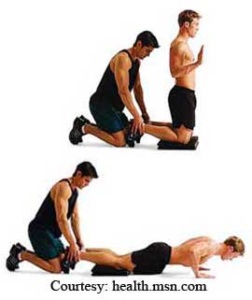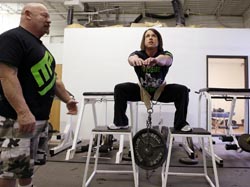 Maximal strength can be defined as your ability to produce the highest level of muscle force. To achieve your highest possible force, you must recruit your largest motor units, the fast-fatigable (FF) motor units that can only sustain their force output for 10 continuous seconds or less.
Maximal strength can be defined as your ability to produce the highest level of muscle force. To achieve your highest possible force, you must recruit your largest motor units, the fast-fatigable (FF) motor units that can only sustain their force output for 10 continuous seconds or less.
So any set that lasts longer than 10 seconds of continuous muscle action isn’t directly training maximal strength because FF motor units have dropped out of the task.
Developing maximal strength is essential. This is especially true for athletes who compete in power sports such as MMA or football where lightning fast, explosive movements are crucial. In order to be powerful, you must be strong.
When it comes to maximal strength training, most people just think of training heavy with compound lifts. So they’ll do 3 sets of 3 reps for the deadlift with the heaviest load they can handle. This approach works well to increase full body strength and bone density. However, lifting heavy all the time can be very draining on the central nervous system (CNS) and tough on your joints. High load exercises and frequent training don’t mix because they result in massive compressive forces through the spine that can take many days to recover from.
That’s the snag for those who want to build muscle fast. In order to get the fastest gains you must train with the highest frequency possible.
Importantly, there’s another way to build maximal strength that often isn’t discussed: with high-tension exercises. A high-tension exercise is one that recruits the FF motor units, but doesn’t necessarily require heavy weights to get the job done.
Think of the iron cross as an example. Most strong guys can’t compete one full range of motion rep. But they can struggle and strain to produce a few high-tension partial reps as they work to get to the full range over time. The same is true with the body weight glute-ham raise. You can hold the top position, and maybe shift a few inches back and forth, and keep this tension going for 10 seconds before you must stop.

So even though there’s no external load, certain body weight exercises can train and develop maximal strength. By using body weight maximal strength exercises (ie, high-tension exercises) instead of high load exercises for most of your workouts, you can get stronger and bigger faster.
Why? Because high-tension body weight exercises don’t induce huge compressive forces through your spine. Indeed, if you keep your spine as decompressed as possible, you’ll hasten recovery. Don’t get me wrong, some spinal compression is necessary and inevitable from exercises such as a heavy deadlift or squat. Those exercises must be part of your program to build full body strength. However, if you’ve spent any amount of time doing heavy training with those exercise you know how fatiguing they can be.
And the squat and deadlift aren’t the only culprits. Some strong guys can do a seated military press with a load that’s heavier than their body weight. The combined spinal compression from sitting paired with the heavy load can really cram your spine. Surprisingly, these same guys usually can’t perform more than one or two handstand push-ups – an exercise that requires high tension in the same muscle groups without the spinal compression. 
The bottom line of this post is to convince you that strength exercises which unload the spine can be performed with a higher frequency for faster strength and muscle gains. You can’t squat super heavy three times per week, but you can squat heavy once per week and perform a hip belt squat for the other two workouts since it doesn’t squash the spine.
 Another example is with the deadlift to increase posterior chain size and strength. Pulling a heavy deadlift three times per week is extremely draining, especially if you use enough volume to induce muscle growth. But you can pull heavy once each week and do the glute-ham raise for the other two workouts.
Another example is with the deadlift to increase posterior chain size and strength. Pulling a heavy deadlift three times per week is extremely draining, especially if you use enough volume to induce muscle growth. But you can pull heavy once each week and do the glute-ham raise for the other two workouts.
In a perfect world you could build full body strength by lifting super heavy three or four times per week with the standing military press, deadlift, and squat. But you can’t. That’s why you need high tension exercises that stress the muscles more than the spine.
So up your training frequency each week for the shoulder press, deadlift, and squat by incorporating these high-tension substitutes: the handstand push-up, glute-ham raise, and hip belt squat.
Stay Focused,
CW
